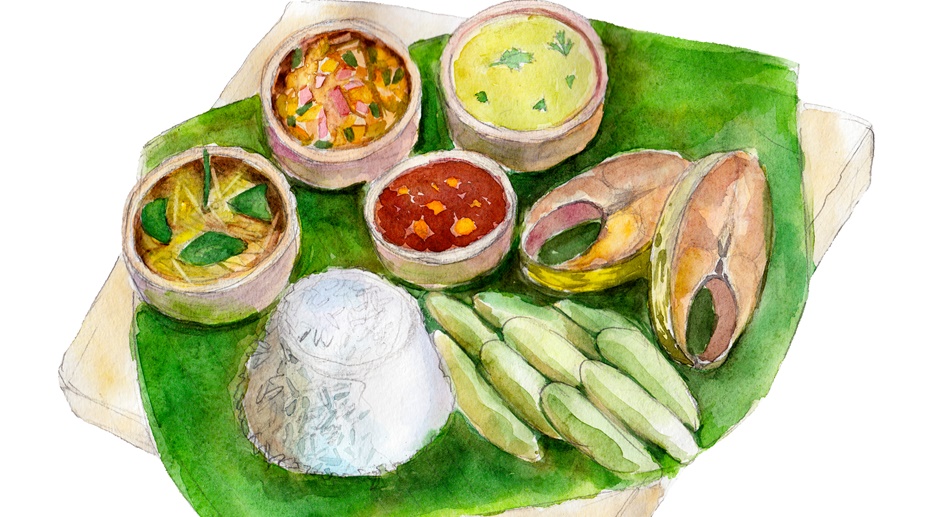A tale of two rivers
So from this Bengali New Year on, let your taste buds get ready for twists in the tale of the Ganga and Padma rivers, as offered by various chefs and food enthusiasts.
Poila Boishakh gives food loving Bengalis the best chance to feast on good old traditional fares

Bengali traditional food served on banana leaf. (Photo: Getty Images)
It’s Poila Boishakh on April 15 — the first day of the Bengali calendar. Bengalis across the world celebrate the day with great fervour. While a trip to the temple, new clothes, a phone call to family members staying away from home and cultural programmes are usually a must on this day, Poila Boishakh is also the day the food loving Bengalis feast on good old traditional fares.
Talking of Bengali food, the first two things that come to your mind are sweets and fish, but they have other favourites too. Here are three dishes a true-blue Bengali can’t live without.
SORSHE ILISH
Advertisement
Fish can be a staple food for Bengalis, who rarely take it for granted. And ilish, or hilsa, can never lose the place it has in the hearts of Bengalis. Ilish can be made in different ways — even the oil after the fish has been fried in it is considered a delicacy. But the dish considered the king of all fish dishes is ‘shorshe ilish’ — the hilsa steamed or shallow fried with raw mustard seeds paste.
The pungent and tangy ‘shorshe ilish’ is the ultimate hilsa delicacy. Here is the recipe.
Ingredients:
Hilsa fish: 500g
Black/red mustard seed: 1/2 cup
Green chillies: 7-8
Mustard oil: To fry
Turmeric powder: 1 teaspoon
Juice of one small lemon (optional) 02
Preparation:
Soak the mustard seeds for at least half an hour, preferably in hot/warm water.
Grind it with 3-4 green chillies and set aside.
Heat oil in a pan and put 3-4 slit green chillies.
Add the fish and turmeric powder and fry till cooked.
Now add the mustard paste with a little water and stir for a couple of minutes.
Turn off the flame and add lemon juice (optional) before serving hot with plain rice.
For the steamed version, mix in all the ingredients and keep it in an airtight stainless steel box. Put it, half soaked in water, in a pressure cooker and let it cook in low flame. Turn off the gas after first whistle.
Tip: You need to be a little careful while using mustard paste, which tends to turn bitter. Use freshly ground paste, and don’t cook it for long. You get readymade mustard paste or powder these days. You can use it according to the directions given on the pack. They taste quite authentic.
READ: UP President Donald Trump greets Bengalis for ‘Noboborsho’
MUTTON CURRY
Spicy, tangy and full of flavours. This traditional recipe of Bengali mutton curry needs no special masala. All you need is a little salt, turmeric and red chilli powder, some ginger-cumin paste and garam masala.
Here goes the recipe.
Ingredients:
Mutton: 1 kg
Onions: 1/2 kg
Tomatoes: 250 g
Ginger-cumin seeds paste: 2 tablespoons
Chilli powder: 1 teaspoon
Turmeric powder: 1/2 teaspoon
Salt: To taste
Potatoes: 4 (cut into halves)
Green chillies: 4-5
Mustard oil: 4 tablespoons
Bay leaf: 2-3
Whole garam masala: 2 teaspoons
Sugar: 1/2 teaspoon
Preparation:
Marinate the mutton with salt, turmeric powder, chilli powder, bay leaves, one tablespoon of mustard oil and the ginger-cumin seeds paste. Also mix in a little sliced onion and tomatoes and set aside.
In the mean time, grind the whole garam masala with a little water and set aside.
Heat oil in a pressure cooker and add the sugar. Once it starts caramelising (be careful, it should not burn), add the rest of the sliced onions and green chillies.
Fry till the onions are soft and then add the marinated mutton.
Once the juices start drying up, add half cup of water and the potatoes and put the pressure cooker lid on.
Turn off the heat after 2-3 whistles, depending on the size/quality of the mutton pieces.
Open the lid after 10-15 minutes. If it’s very watery, turn on the gas again and cook it till you get the desired consistency.
Add the ground garam masala before serving hot with fried or plain rice.
TIP: Bengali dishes taste best when cooked in mustard oil. To avoid any spell, ensure the oil is piping hot before anything goes into it. The sugar used in this mutton dish is more for colour than taste. Grind the garam masala on sil-batta (traditional stone grinder) for more authentic taste.
MISHTI DOI
Mishti Doi is one of the oldest Bengali sweets and is widely popular. Rich in taste, the good old Mishti Doi, or sweet yoghurt, is quite easily available these days in packaged form. Old-timers, however, like it the traditional way — served in earthen pots that soak up all the loose water leaving the rich sweetness to relish.
You usually get the best Mishti Doi in shops specialising in Bengali sweets, but can be easily made at home. Here goes the recipe.
Ingredients:
Milk: 1 litre (full cream)
Sugar: 6 tablespoons
Curd/yoghurt: 2 tablespoons
Preparation:
Heat the milk with 4 tablespoons of sugar and keep boiling it till it reduces to half.
Now, heat a pan and caremalise 2 tablespoons of sugar. Add the boiling milk to the caremalised sugar and stir till the sugar completely dissolves.
Let the milk cool down to room temperature.
Mix in the yoghurt now and pour the mixture into an earthen pot and leave it overnight.
Once set, refrigerate. Serve chilled.
TIP: Do not add yoghurt when the milk is hot, it will curdle. Ajdusting the amount of sugar and heat while caremalising it can bring the shade you want for your Mishti Doi.
Advertisement